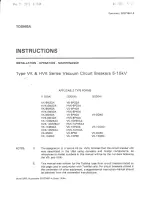
I.B. 70A2580H02
Page 15
Effective November 2012
SECTION 5: DESCRIPTION AND OPERATION
5-1 INTRODUCTION
The Type VCP-Wind 38kV Vacuum Circuit Breaker is a
horizontal drawout roll on the floor design for use in new
switchgear, as well as for modernization and life
extension of existing switchgear. The circuit breakers
meet or exceed all applicable IEEE Standards.
Circuit breakers are operated by a motor charged
spring type stored energy mechanism, charged
normally by an electric motor or manually by a manual
charging tool. The primary disconnecting contacts are
self-aligning, silver plated copper. VCP-Wind
Circuit
Breakers are of a modular type construction containing
a front accessible mechanism with unobstructed access
to control components.
The primary insulation used in the circuit breaker design
is epoxy. Type SIS, AWG #14 control wire with cross-
linked polyolefin insulation is used throughout the
control circuits with all terminals being of the screw
type. This section describes the overall operation of the
circuit breaker as well as the function and operation of
all major sub-assemblies and/or parts.
5-2 VACUUM INTERRUPTER
VCP-Wind 38kV Vacuum Circuit Breakers utilize vacuum
interrupters for interruption and switching functions. The
vacuum interrupters use axial-magnetic, copper chrome
contacts for superior dielectric strength, better
performance characteristics, and lower chop current.
Vacuum interruption provides the advantages of
enclosed interrupters, reduced size and weight, short
interrupting time, long life, reduced maintenance, and
environmental compatibility.
Arc interruption is simple and fast (Figure 5-1).
In the
closed position, current flows through the interrupter.
When the contacts are opened, the arc is drawn between
the contact surfaces. It is moved rapidly around the
slotted contact surfaces by a self-induced magnetic force
which prevents gross contact erosion as well as the
formation of hot spots on contact surfaces. The arc burns
in an ionized metal vapor which continually leaves the
contact area and condenses on the surrounding metal
shield.
5-2.1 INTERRUPTER ASSEMBLY
The VCP-Wind design utilizes three individually
mounted pole units. Each pole unit is encapsulated
in an epoxy support molding. (Figure 3-3).
The
disconnecting ends of the primary conductors utilize
round, floating type primary disconnecting finger
clusters for interfacing with the switchgear structure
mounted primary conductors.
Figure 5-1 Graphic Representation of Arc Interruption
At current zero, the arc is extinguished and vapor
production ceases. Very rapid dispersion, cooling,
recombination, and deionization of the metal vapor
plasma, together with the fast condensation of metal
vapor products, cause the vacuum to be quickly
restored. Hence, the opened contacts withstand the
transient recovery voltage.
5-2.2 CONTACT EROSION
Contact erosion for the vacuum interrupter is
negligible and no re-adjustment of the breaker is
needed after initial assembly and no additional
contact wipe to compensate for contact erosion
during the entire life of the circuit breaker.














































